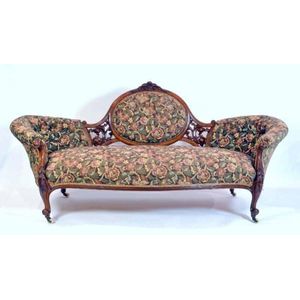Walnut Boudoir Canape with Floral Crest and Acanthus Leaves
You must be a subscriber, and be logged in to view price and dealer details.
Subscribe Now to view actual auction price for this item
When you subscribe, you have the option of setting the currency in which to display prices to $Au, $US, $NZ or Stg.
- Rail - A term used by cabinet makers for the horizontal sections of the frame of an item such as a chair or settee which have a front rail, a back rail and two side rails, and also on a door or carcase, where the rails are joined to the vertical framings.
- Cabriole Leg - The cabriole leg evolved from an elongated scroll, curving out at the knee which may or may not be carved, and forming a serpentine shape as it descends to the foot.
First introduced into English furniture in the late 17th century, cabriole legs were widely used during the Queen Anne and early Georgian periods, where they frequently terminated in a pad foot or ball and claw foot. The style has had many imitators since then. The cabriole leg was re-introduced in the mid-19th century, and is commonly associated with the balloon-back dining or drawing-room chairs made in walnut, mahogany or, in Australia, cedar. The Victorian cabriole leg, on the whole, was rather more slender than the earlier form, following the French style, which emphasized the delicacy and daintiness of the chairs they were designed to support. Cabriole legs are sometimes found on windsor chairs, especially those made during the 18th century. - Acanthus - A stylized leaf motif, one of the primary decorative elements of classical Greek and Roman architecture, derived from the genus of flowering plants in the family Acanthaceae, native to tropical and subtropical regions of the Mediterranean area. It is a common element in classical Greek and Roman design, and is often seen in Corinthian and Composite order columns and used as a decorative element in English, European and Australian furniture, particularly on the curve of a leg, and as decoration for a corbel.
This item has been included into following indexes:
Visually similar items

A West Australian Colonial jarrah settle, c.1870-1880. The settle is all jarrah construction, with double end arm rests, with three turned spindles, swan neck and sabre style legs, and serpentine style back board, with later upholstered cushion. Height 90

Victorian double end chaise lounge c.1880, mahogany, with later upholstery, decorated carved top back rail, carved scrolling, arms and cabriole legs with ceramic castors. Height 97 cm. Length 212 cm

A seven piece giltwood suite, circa 1870-1880, upholstered in silk Aubusson fabric, settee, 110 x 154 x 65 cm, armchairs, 104 x 70 x 57 cm, chairs, 108 x 55 x 50 cm

Louis XV style three piece salon suite, comprising a canape and two fauteuils, with carved giltwood frames, covered in a cream and pale pink damask fabric (3), height 108 cm width 179 cm depth 62 cm (canape), height 102 cm (chair)
